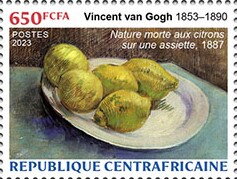Stamp: "Still Life with Lemons on a Plate", 1887 (Central African Republic 2023)
"Still Life with Lemons on a Plate", 1887 (Central African Republic 2023)
12 January (Central African Republic ) within release Vincent van Gogh (2023) goes into circulation Stamp "Still Life with Lemons on a Plate", 1887 face value 650 Central African CFA franc
| Stamp "Still Life with Lemons on a Plate", 1887 in catalogues | |
|---|---|
| Yvert et Tellier: | Yt: CF 10359 |
Stamp is square format.
Also in the issue Vincent van Gogh (2023):
- Mini Sheet - 170th Birth Anniversary of Vincent van Gogh face value 4*650;
- Souvenir Sheet - 170th Birth Anniversary of Vincent van Gogh face value 3,600;
- Stamp - "First Steps, after Millet", 1890 face value 650;
- Stamp - "Garden with Flowers", 1888 face value 650;
- Stamp - "Still Life with Lemons on a Plate", 1887 face value 650;
- Stamp - "The Dance Hall in Arles", 1888 face value 650;
- Stamp - "The Novel Reader", 1888 face value 650;
- Stamp - "Undergrowth with Two Figures", 1890 face value 650;
Stamp "Still Life with Lemons on a Plate", 1887 it reflects the thematic directions:
In botany, a berry is a fleshy fruit without a drupe (pit) produced from a single flower containing one ovary. Berries so defined include grapes, currants, and tomatoes, as well as cucumbers, eggplants (aubergines), persimmons and bananas, but exclude certain fruits that meet the culinary definition of berries, such as strawberries and raspberries. The berry is the most common type of fleshy fruit in which the entire outer layer of the ovary wall ripens into a potentially edible "pericarp". Berries may be formed from one or more carpels from the same flower (i.e. from a simple or a compound ovary).: 291 The seeds are usually embedded in the fleshy interior of the ovary, but there are some non-fleshy exceptions, such as Capsicum species, with air rather than pulp around their seeds.
Painting is the practice of applying paint, pigment, color or other medium to a solid surface (support base). The medium is commonly applied to the base with a brush, but other implements, such as knives, sponges, and airbrushes, can be used. Painting is a mode of creative expression, and the forms are numerous. Drawing, gesture (as in gestural painting), composition, narration (as in narrative art), or abstraction (as in abstract art), among other aesthetic modes, may serve to manifest the expressive and conceptual intention of the practitioner. Paintings can be naturalistic and representational (as in a still life or landscape painting), photographic, abstract, narrative, symbolistic (as in Symbolist art), emotive (as in Expressionism), or political in nature (as in Artivism). A portion of the history of painting in both Eastern and Western art is dominated by spiritual motifs and ideas. Examples of this kind of painting range from artwork depicting mythological figures on pottery, to Biblical scenes rendered on the interior walls and ceiling of the Sistine Chapel, to scenes from the life of Buddha or other images of Eastern religious origin. In art, the term painting describes both the act and the result of the action. The support for paintings includes such surfaces as walls, paper, canvas, wood, glass, lacquer, clay, leaf, copper and concrete, and the painting may incorporate multiple other materials including sand, clay, paper, plaster, gold leaf, as well as objects. The term painting is also used outside of art as a common trade among craftsmen and builders.


